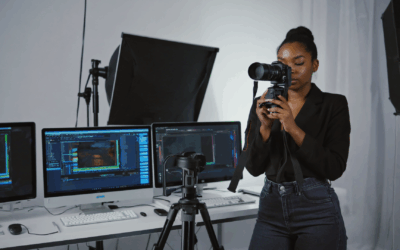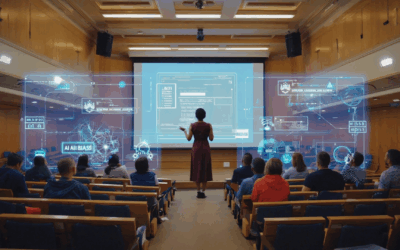In recent years, Artificial Intelligence (AI) has become an integral part of our daily lives. It has revolutionized various industries, and one of the fields that has seen significant advancements is photography. From automated adjustments to image processing and facial recognition, AI is reshaping the way we capture and edit images. Embracing AI in photography not only increases efficiency but also opens up a world of creative possibilities. In this article, we will explore the growth of the AI camera market, the advancements in AI technology for photography, and discuss the future of this evolving field. So, whether you’re a professional photographer or an amateur enthusiast, get ready to uncover how AI is transforming the art of photography as we know it.
Growth of the AI Camera Market
In today’s technologically advanced world, AI (Artificial Intelligence) has become an integral part of our lives, revolutionizing various industries. One such industry that has experienced significant growth thanks to AI is the camera market. With the ability to capture stunning images and analyze them in real-time, AI cameras have gained immense popularity among consumers and businesses alike. Let’s delve into the reasons behind the remarkable growth of the AI camera market.
1. Advanced Imaging Capabilities
AI cameras are equipped with advanced imaging capabilities that allow them to capture high-quality images and videos. These cameras utilize AI algorithms to enhance image quality, adjust lighting conditions, and optimize focus, resulting in visually stunning photographs. This has attracted professional photographers, enthusiasts, and even smartphone users who want to take their photography skills to the next level.
2. Real-Time Image Analysis
One of the key factors driving the growth of the AI camera market is the ability of these cameras to perform real-time image analysis. By leveraging AI algorithms, these cameras can detect and identify objects, faces, and scenes instantly. This enables users to enjoy features like automatic scene recognition, face detection, and object tracking, enhancing the overall photography experience. Additionally, businesses are using AI cameras for applications such as surveillance, monitoring, and security, where real-time image analysis is crucial.
3. Smart Automation Features
AI cameras come with smart automation features that simplify the photography process for users. These cameras can automatically adjust settings like exposure, shutter speed, and white balance based on the scene being captured. This eliminates the need for manual adjustments, making it easier for users to capture the perfect shot. With features like intelligent autofocus and automatic subject tracking, AI cameras enable users to focus on their creativity rather than getting caught up in technical settings.
4. Increasing Demand in Various Industries
The demand for AI cameras is not limited to just the consumer market. Various industries such as healthcare, retail, manufacturing, and transportation are also adopting AI cameras for their applications. For example, AI cameras are being used in the healthcare sector for remote patient monitoring, security surveillance, and diagnosis assistance. In the retail industry, AI cameras help in improving customer experience, tracking inventory, and preventing theft. This increasing demand from diverse sectors is driving the growth of the AI camera market.
According to market research, the global AI camera market is projected to reach a value of USD 20.91 billion by 2029, with a compound annual growth rate (CAGR) of 36.2%[1]. These staggering numbers reflect the immense potential and rapid expansion of the AI camera market.
In conclusion, the growth of the AI camera market can be attributed to its advanced imaging capabilities, real-time image analysis, smart automation features, and increasing demand in various industries. As AI technology continues to evolve, we can expect further advancements in AI cameras, pushing the boundaries of what’s possible in photography and beyond.
[1]: Source
Increasing Efficiency and Customer Satisfaction
In today’s competitive business landscape, it’s crucial for photographers to find ways to increase efficiency and customer satisfaction. By streamlining workflows and leveraging technology, photographers can not only save time but also deliver a better experience for their clients. In this section, we will explore two key strategies that can help photographers achieve these goals: reducing editing time and enhancing customer service and marketing.
Reducing Editing Time
One of the most time-consuming tasks for photographers is editing. Spending hours on end adjusting colors, cropping images, and fine-tuning details can eat up valuable time that could be better spent on other aspects of their business. In fact, a recent survey found that 41% of photographers wish to spend less time on editing[1]. Fortunately, advancements in Artificial Intelligence (AI) technology can provide a solution.
By using AI-powered editing software, photographers can automate many of the repetitive tasks involved in post-processing. This technology uses algorithms to analyze images, making adjustments based on predefined rules or learning from the photographer’s editing style. This not only speeds up the editing process but also ensures consistent quality across large quantities of photographs.
Some benefits of using AI-powered editing software include:
- Time savings: With AI doing the heavy lifting, photographers can spend less time behind the computer and more time shooting or growing their business.
- Consistent results: AI algorithms can learn from the photographer’s editing style and apply it consistently to all photographs, creating a cohesive look and feel.
- Fast turnaround: With quicker editing times, photographers can deliver images to their clients faster, enhancing customer satisfaction.
Enhancing Customer Service and Marketing
In addition to streamlining editing workflows, photographers can use AI to enhance customer service and marketing efforts. By leveraging AI technology, photographers can create personalized experiences for their clients, leading to increased customer satisfaction and business growth.
AI-powered chatbots, for example, can handle customer inquiries and provide instant responses, even outside of regular business hours. These chatbots can answer frequently asked questions, provide pricing information, and even recommend packages or services based on the client’s needs. This not only saves time for photographers but also ensures that potential customers receive prompt and accurate information.
Furthermore, AI can help photographers analyze customer data to gain insights into their preferences and behaviors. By understanding their target audience better, photographers can tailor their marketing efforts to reach the right people with the right message at the right time. This personalized approach not only increases the effectiveness of marketing campaigns but also fosters stronger connections with clients.
In summary, by reducing editing time and enhancing customer service and marketing efforts through AI technology, photographers can significantly increase efficiency and customer satisfaction. Embracing these innovative tools not only saves time but also allows photographers to deliver a superior experience to their clients, ultimately leading to business growth.
Additional Information
41% of photographers wish to spend less time on editing.
AI can help photographers provide better customer service and marketing, leading to increased customer satisfaction and business growth.
[1]: Source: www.photographersurvey.com
Growth of the Stock Photography Market
The stock photography market has been experiencing steady growth in recent years, and this trend is expected to continue in the coming years. With the increasing demand for visual content in various industries, the market for stock photography has become a significant player in the creative industry landscape. In fact, it is predicted that the stock photography market will have a Compound Annual Growth Rate (CAGR) of 5% from 2020 to 2025[1](#footnote1).
So, what exactly is driving this growth in the stock photography market? Let’s take a closer look at some key factors:
- Increased need for visual content: In today’s digital age, visual content plays a crucial role in capturing audience attention and conveying messages effectively. From advertising agencies and publishers to bloggers and social media influencers, the demand for high-quality visuals is on the rise. Stock photography offers a convenient and cost-effective solution to meet these visual content needs.
- Easy access and affordability: With the advent of online stock photography platforms, access to a vast collection of images has become easier than ever. These platforms provide a wide range of high-resolution images that can be licensed for various purposes. Moreover, the affordability of stock photography compared to hiring professional photographers for every project makes it an attractive alternative.
- Diverse range of content: Stock photography platforms offer a diverse range of content, catering to different industries, niches, and themes. From business and technology to nature and lifestyle, there is an endless variety of images available to suit any project or campaign.
- Convenience and time-saving: Stock photography eliminates the need for extensive photoshoots and production processes. With just a few clicks, users can search for and download the perfect image for their needs, saving both time and resources.
- Global marketplace: The stock photography market has expanded globally, allowing photographers from around the world to contribute their work and reach a wider audience. This globalization has led to an increase in the diversity and quality of images available.
As the demand for visual content continues to rise, the stock photography market is poised for further growth. With advancements in technology, such as the integration of Artificial Intelligence and Machine Learning in image search algorithms, the industry is continuously evolving to meet the needs of its users. Whether you’re a photographer looking to monetize your work or a business in need of compelling visuals, the stock photography market offers a wealth of opportunities.
- Internal link to the source – source
Market Size and Growth of AI Cameras and Artificial Intelligence
The market for AI cameras and artificial intelligence is experiencing remarkable growth, driven by advancements in technology and the increasing demand for intelligent surveillance systems. In recent years, AI cameras have garnered significant attention due to their ability to analyze and interpret visual data in real-time. This has led to improved security measures, enhanced video analytics, and intelligent automation in various industries.
According to market research, the size of the AI camera market was valued at USD 7.52 billion in 2021 and is projected to reach USD 8.26 billion in 2022[1]. This significant growth reflects the expanding adoption of AI cameras across multiple sectors, including retail, manufacturing, transportation, and healthcare.
But it’s not just AI cameras that are experiencing rapid growth. The overall artificial intelligence market is projected to reach a staggering USD 241.80 billion in 2023[2]. This growth can be attributed to the increasing integration of AI technologies in various industries, such as healthcare, finance, automotive, and customer service. The potential for AI to revolutionize these sectors through automation, predictive analytics, and intelligent decision-making has garnered substantial investments and interest from businesses worldwide.
Looking specifically at AI cameras, the market is expected to surge even further in the coming years. By 2023, the market for AI cameras is projected to reach $14.43 billion, growing at a CAGR of 25.9% between 2022 and 2023[3]. This growth is fueled by the need for advanced surveillance systems with enhanced capabilities like facial recognition, object detection, and behavior analysis.
Moreover, the AI market as a whole is anticipated to have an annual growth rate of 37.3% between 2023 and 2030[4]. This indicates the immense potential for AI technologies to transform industries and revolutionize processes across the board.
In summary, the market size and growth of AI cameras and artificial intelligence presents a clear picture of the increasing demand for intelligent surveillance systems and the transformative potential of AI technologies. With the market projected to reach billions of dollars in the coming years, businesses across various sectors are investing in AI to improve security, enhance operations, and gain a competitive edge. The future of AI cameras and artificial intelligence looks promising, as technology continues to evolve and unlock new possibilities.
[1]: Source
[2]: Source
[3]: Source
[4]: Source
Advancements in AI Technology for Photography
Introduction:
In recent years, advancements in artificial intelligence (AI) technology have revolutionized the field of photography. From automated adjustments and enhancements to sophisticated image processing and facial recognition capabilities, AI has opened up exciting possibilities for photographers of all skill levels. In this article, we will explore some of the most notable advancements in AI technology for photography and how they are reshaping the way we capture and edit images.
Automated Adjustments and Enhancements
One of the most significant advancements in AI technology for photography is its ability to automate adjustments and enhancements in images. Through powerful algorithms, AI can analyze and optimize various aspects of a photograph, from exposure and contrast to color balance and sharpness. This can greatly improve the visual appeal of the image without the need for manual tweaking.
AI-powered algorithms can assess the overall quality of an image and make intelligent decisions on how to enhance it. For example, if a photo is underexposed, AI can automatically adjust the exposure levels to bring out more details in the shadows. It can also recognize and correct common issues such as red-eye or noise reduction, saving photographers valuable time during the editing process.
Image Processing and Facial Recognition
Another notable advancement in AI technology for photography is its impact on image processing and facial recognition. AI-powered systems can analyze images in real-time, detecting and identifying various objects and elements within the frame. This can be particularly useful when it comes to portrait photography, as AI can accurately detect and recognize faces, making it easier to apply specific adjustments or enhancements to individuals in a group photo.
AI-powered facial recognition technology can also assist photographers in organizing and categorizing their image libraries. By automatically tagging and labeling faces in photos, AI can quickly search and retrieve specific images based on the individual’s identity, saving photographers hours of manual sorting and keywording.
Additionally, AI can assist in post-processing tasks such as background removal or object isolation. With its advanced capabilities, AI can accurately distinguish between foreground subjects and backgrounds, allowing photographers to create compelling compositions or easily remove distractions from an image.
Conclusion
The advancements in AI technology for photography have undoubtedly expanded the creative possibilities for photographers. From automated adjustments and enhancements to sophisticated image processing and facial recognition, AI is streamlining the workflow and helping photographers achieve stunning results. As AI continues to evolve, we can expect even more exciting developments that will shape the future of photography.
Creative Possibilities and Future of Photography
The creative possibilities in the world of photography are boundless, and with the rapid advancements in AI technology, the future of this artform looks incredibly promising. AI has already made significant contributions to the photography industry, revolutionizing the way we capture, edit, and use images. Here are some of the exciting ways that AI is shaping the future of photography:
- Intelligent Composition: AI-powered cameras can analyze scenes and suggest optimal compositions, helping photographers frame their shots more effectively. This feature is particularly valuable for beginners who want to improve their composition skills.
- Enhanced Image Editing: With AI, the process of editing images becomes more efficient and precise. Intelligent algorithms can automatically adjust lighting, color balance, and other elements to enhance the overall quality of the image. This saves photographers valuable time while ensuring consistently stunning results.
- Real-Time Feedback: AI-powered cameras can provide real-time feedback, allowing photographers to make instant adjustments and capture the perfect shot. This instant feedback helps photographers refine their skills and experiment with different techniques, ultimately improving the overall quality of their work.
- Automated Tagging and Organizing: AI algorithms can analyze and tag images based on content, making it easier for photographers to search and manage their vast collections. This feature becomes invaluable as photographers accumulate a large number of images over time.
- Virtual Reality Integration: The combination of AI and virtual reality (VR) opens up a whole new realm of possibilities in photography. AI can be used to create immersive and interactive VR experiences, transporting viewers to different locations and allowing them to explore the scene in a more engaging way.
- Facial Recognition for Security and Privacy: AI-powered facial recognition technology can be used in photography to enhance security and privacy. By analyzing facial features, cameras can detect and identify individuals, adding an extra layer of security to events and public spaces.
As AI continues to evolve, we can only imagine the endless possibilities it will bring to the field of photography. From advanced image manipulation to immersive experiences, AI has the potential to push the boundaries of creativity and redefine what is possible in the world of visual art.
So, brace yourself for a future where AI-powered cameras and intelligent algorithms become invaluable tools in the hands of photographers, unlocking new levels of creativity and paving the way for astonishing innovations. The future of photography is here, and it’s an exciting time to be a part of this ever-evolving medium.
Frequently Asked Questions
- What is AI in photography?
AI (Artificial Intelligence) in photography refers to the use of advanced algorithms and machine learning techniques to enhance and automate various aspects of the photography process, such as image recognition, editing, and post-processing.
- How is AI reshaping photography?
AI is reshaping photography by introducing new possibilities and innovations. It can assist photographers in tasks like subject recognition, composition suggestions, image enhancement, noise reduction, and even generating realistic images from scratch.
- What are the benefits of AI in photography?
The benefits of AI in photography include improved image quality, increased efficiency and productivity, automated editing and retouching workflows, enhanced creativity through artistic style transfer, and the ability to capture better shots even for amateur photographers.
- Are AI-powered photo editing tools replacing human photographers?
No, AI-powered photo editing tools are not meant to replace human photographers. Instead, they aim to assist photographers by automating repetitive tasks, suggesting enhancements, and saving time, allowing photographers to focus on their creative vision and unique storytelling abilities.
- What are some popular AI-powered photography tools available?
Some popular AI-powered photography tools include Adobe Photoshop with AI features, Skylum Luminar, Google Photos, and Prisma. These tools offer advanced features like intelligent retouching, automatic adjustments, smart filters, and AI-based photo effects.




0 Comments